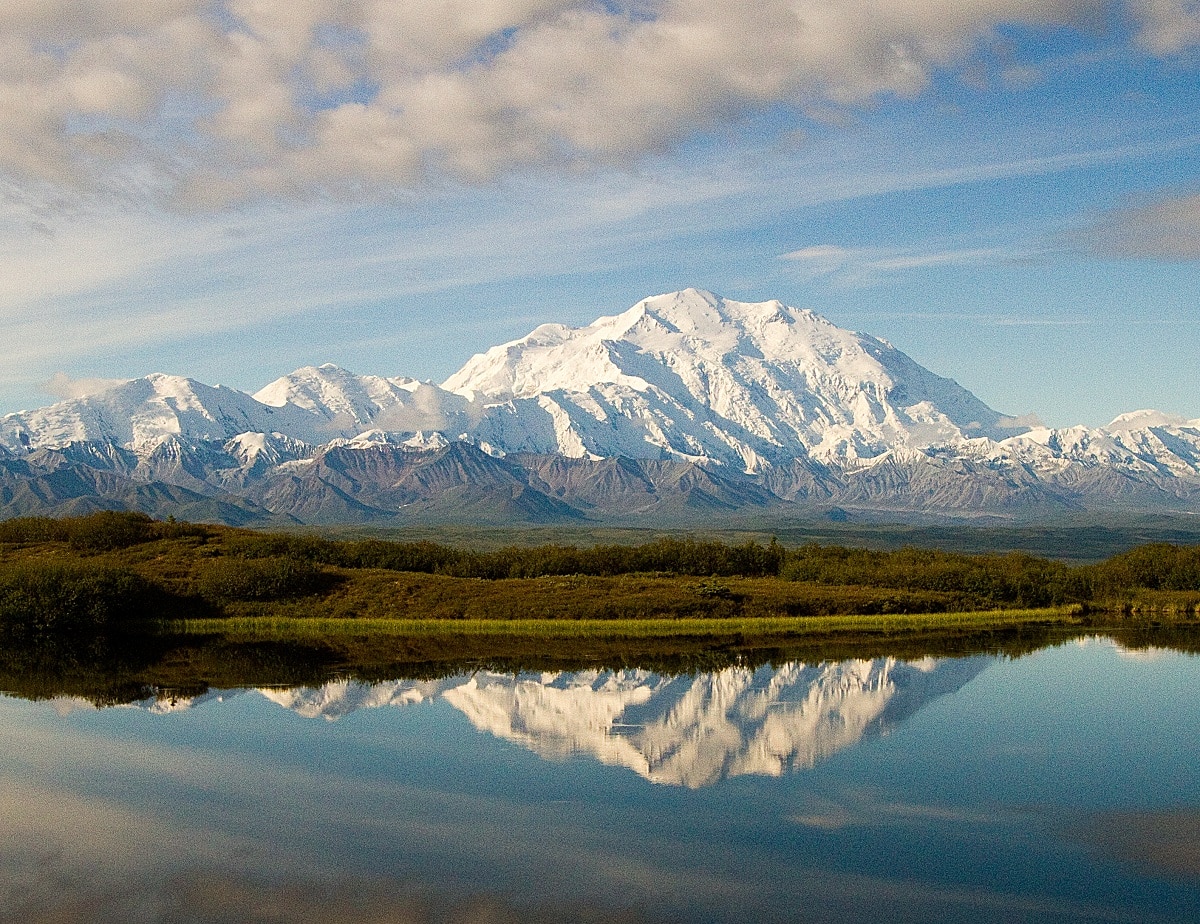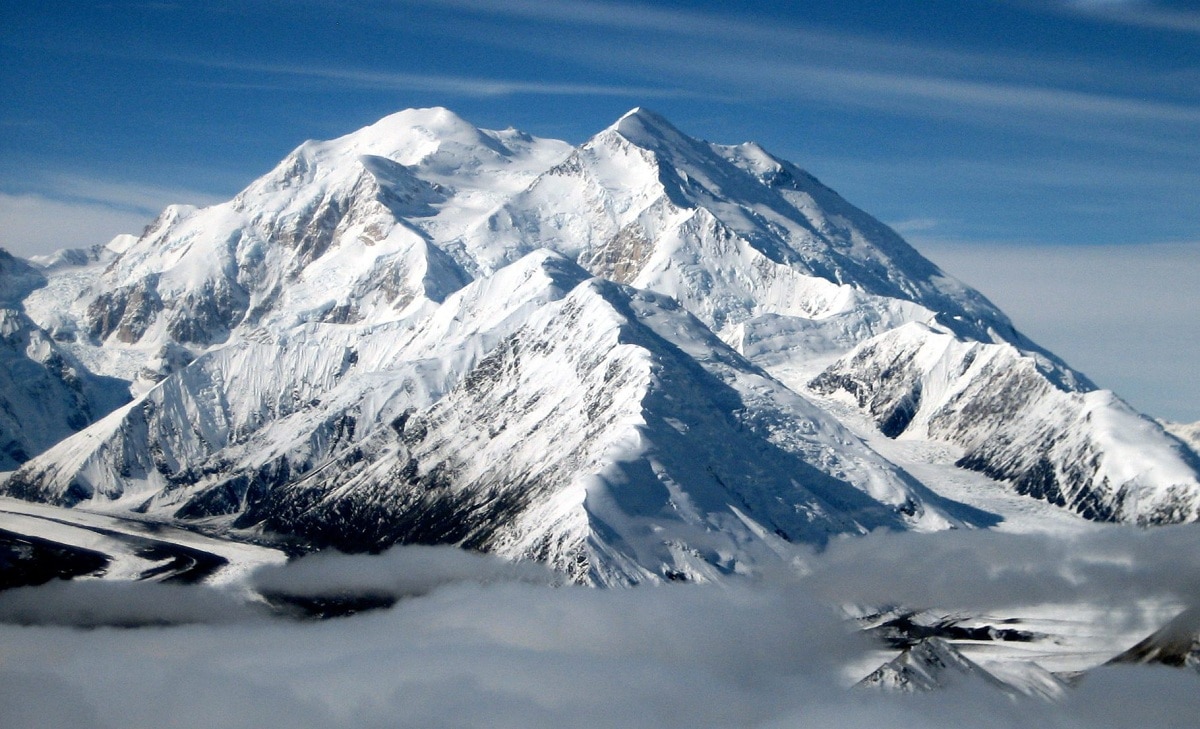
El mount denali It has been known as Mount McKinley for years, but its official name, recognized by the US government, is Denali, given to it by the local Athabasca people long ago. It is undoubtedly the highest peak in North America and the only mountain on the continent with an elevation of more than 6.000 meters. It is also the third most prominent mountain and the third most isolated mountain after Aconcagua and Everest. One day in 1794, the navigator George Vancouver saw it for the first time from Cook's Bay, but it was not until 1901 that he attempted to climb it.
In this article we are going to tell you everything you need to know about Mount Denali, its characteristics and importance.
Key features

Denali or McKinley is part of the Alaska Range, part of the Pacific Ring of Fire. It is particularly located near the center of Denali National Park and Preserve, along south-central Alaska and along the Denali Fault. It consists of a large expanse of tall granite and has two major peaks that are always covered in snow:
- North Peak. Sometimes it is considered a single peak.
- South Peak. He is the taller of the two.
The entire upper part of the mountain is covered by a layer of snow and several major glaciers. The snow feeds 5 glaciers on the slopes: Muldrow Glacier, Ruth Glacier, Kahiltna Glacier, Peters Glacier and Traleika Glacier.
The mountain is more than 6.190 meters above sea level. While temperatures on the slopes allow many species to thrive, temperatures on the peaks are high. In winter they can reach -70,5 ºC. Winds can be strong; Gusts of up to 241 km/h were recorded during the storm.
Formation of Mount Denali

About 60-65 million years ago, During a period of high geological activity characterized by the frequent movement of the Earth's tectonic plates, Mount Denali began to form. The mountains, in turn, are the result of a rupture in the earth's crust - the Denali Fault. As the plates moved, the Pacific plate was so close to the North American plate that it sank due to differences in pressure, temperature, and other factors between the two.
In other words, Mount Denali is the result of the Pacific plate subducting under the North American plate, and during the subduction process, the surface of Alaska began to bend and fold, creating many uplifts that formed the Alaskan mountains.
According to the US National Park Service (NPS), Mount Denali was "born" about 56 million years ago when molten magma hardened below the earth's crust; however, despite the involvement of magma in its formation, it was not a volcano. Over millions of years, the mountain has risen due to pressure between tectonic plates, but its surface has also eroded. The mountain continues to grow at a rate of about 1 mm per year.
Flora and fauna of Mount Denali
Mount Denali is home to at least 650 species of flowering plants and various species of ferns, fungi, algae and lichens. Although coniferous forests, tundra, glacial rivers, and even floodplains can be seen on the slopes and valleys, the low temperatures and altitude prevent anything but woody vegetation and low plants from growing in the upper regions. The park has white spruce (Picea glauca) and birch (Betula papyrifera) forests and has a subarctic climate.
Wildlife in the area includes approximately 167 species of birds, 10 species of fish, 39 species of mammals, and 1 amphibian.. Some of the park's inhabitants are red foxes (Vulpes vulpes), red squirrels (Sciurus vulgaris), black bears (Ursus americanus), brown bears (Ursus arctos), coyotes (Canis latrans), wolverines (Gulo gulo), marmots ( Marmota monax), muskrat (Ondatra zibethicus), gray jay and capercaillie (Lagopus lagopus).
Trekking

The view of Mount McKinley from the town of Talkeetna is truly impressive in its sheer size and almost isolated presence. It is one of only six thousand places in the world located above 43º north of the equator, the rest are between 43º north and 32º south latitude.
A suitable period to face the challenge of climbing the McKinley Massif is limited to a short period between the beginning of May and the end of June, since it is at this time when the weather conditions are more favorable and the winters are very low due to the high temperatures. temperatures. and usually massive avalanches in summer.
According to some barometric measurements, the atmospheric pressure at the top of Mount McKinley is close to 7 parts per thousand. Its proximity to the Arctic Circle and its considerable elevation make it one of the coldest mountains on Earth. Denali's peaks are almost 2000 meters higher (prominent) than the surrounding peaks, so blizzards and blizzards can be quite severe in bad weather.
Some history
Although the locals already knew it, they called it Denali, but in the late XNUMXth century, the first whites to see the majestic mountain were gold rush explorers. Surprised by its impressive silhouette, they soon organized an expedition to the summit.
After two failed attempts to reach the top, Dr. Frederick A. Cook decided to make one last attempt in August 1906, accompanied only by a local assistant.
Upon his return, he made sure he had reached the top, earning him high praise from climbers. After the publication of the book Reaching the Top of the Continent, which recounts the feat, including photos of the supposed summit, several of the explorers who accompanied him on his first attempt claimed to know exactly where the photos were taken. This led them to organize an expedition in 1910 to disprove the doctor's claims.
Following the route he described, they reached what they believed to be the end of the real story and took the same photos that Cook posted. They were about 30 kilometers from the top of the mountain. Meanwhile, a group of climbers who had traveled from the south to the summit returned with the certainty that they had arrived, and to prove it, they left a 4-meter pole on which they raised a flag.
In 1912, Brown and Parker, with the help of the third man Merle LeVoy, had organized an expedition against the Doctor to try again. After a tough climb and bad weather conditions, they decided to return to base camp when they almost reached the top. Among the many misfortunes that they encountered along the way, it should be noted that as soon as they came down from the mountain they felt one of the largest earthquakes known, the one that accompanies the eruption of Mount Katmai. All the great ice peaks they had to climb, they were reduced to blocks of ice scattered across the snow.
I hope that with this information you can learn more about Mount Denali and its characteristics.